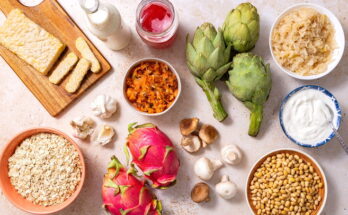Dutch Baby Recipe: Let’s talk about one of the easiest yet most impressive brunch recipes: the Dutch Baby. Don’t let the name fool you—this is neither Dutch nor a baby! A Dutch Baby, sometimes called a German pancake, is a big, fluffy pancake that puffs up dramatically in the oven. It’s crispy on the edges, soft in the center, and unbelievably versatile.
So, why is it a must-try? Not only does it look stunning straight out of the oven, but it’s also incredibly easy to make. With a handful of pantry ingredients and minimal effort, you’ll create a dish that looks gourmet but feels homey.
Ready to dive in? Let’s get started!
Ingredients Needed
Here’s a quick checklist of what you’ll need:
- 3 large eggs (room temperature).
- ½ cup all-purpose flour.
- ½ cup whole milk (room temperature).
- 1 tablespoon sugar (optional for savory versions).
- 1 teaspoon vanilla extract (for sweetness).
- ¼ teaspoon salt.
- 2 tablespoons unsalted butter (for the pan).
Substitutions and Alternatives:
- Use almond or oat milk for a dairy-free option.
- Replace all-purpose flour with gluten-free flour for a GF Dutch Baby.
- Want it savory? Skip the sugar and vanilla, and add a pinch of herbs.
Tools and Equipment
For the perfect Dutch Baby, you’ll need:
- A cast-iron skillet (10-12 inches is ideal).
- A mixing bowl and whisk.
- A blender (optional but helpful).
- A spatula for serving.
No cast-iron skillet? Use an oven-safe pan or baking dish. The key is ensuring the pan retains heat well.
The Science Behind the Puff
What makes a Dutch Baby rise dramatically in the oven? The secret lies in steam. The batter’s high moisture content, combined with a preheated pan and oven, creates a burst of steam that puffs the pancake. No baking powder or soda is needed—just the natural magic of eggs and heat.
Pro Tips for Maximum Puff:
- Ensure your eggs and milk are at room temperature.
- Whisk or blend the batter until smooth (but don’t overmix).
- Preheat the pan to get an instant rise when the batter hits.
Step 1: Preheat Your Oven
A hot oven is non-negotiable for a successful Dutch Baby. Preheat your oven to 425°F (220°C) and place your skillet in the oven while it heats up.
Why preheat the pan? A sizzling hot pan ensures the batter starts cooking immediately, giving you that signature puff.
If using a baking dish, treat it the same way—hot pan, hot oven!
Step 2: Prepare the Batter
While the oven heats, it’s time to make the batter:
- Crack the eggs into a bowl and whisk until frothy.
- Add the milk, flour, sugar (if using), vanilla, and salt.
- Whisk or blend until smooth and lump-free.
The batter should be thin, almost like crepe batter. Let it rest for a few minutes to relax the gluten—it helps the Dutch Baby rise evenly.
Step 3: Heating the Pan
Once your oven has fully preheated, it’s time to prep the pan. Carefully remove the hot skillet from the oven (use oven mitts!). Add the 2 tablespoons of unsalted butter and swirl it around until the pan is fully coated. The butter should melt quickly, creating a thin, sizzling layer.
Why preheat the pan with butter? This step ensures the batter doesn’t stick and helps create a beautifully golden, crispy edge. Be careful not to burn the butter—work quickly and efficiently.
Step 4: Pouring and Baking
Now for the exciting part! Pour your prepared batter into the hot, buttered skillet. You’ll hear a satisfying sizzle as the batter hits the pan—that’s the sound of success.
How to pour the batter:
- Pour it evenly into the center of the pan.
- Avoid stirring or spreading the batter; it will naturally even out.
Place the skillet back into the oven on the center rack and close the door gently. Resist the urge to peek for at least 15 minutes! Opening the oven early can cause the Dutch Baby to deflate.
Step 5: Perfect Timing and Temperature
Bake your Dutch Baby for 20-25 minutes at 425°F (220°C) until the edges are deeply golden and the center is puffed up like a soufflé.
What to look for:
- The edges should curl upwards, forming a bowl-like shape.
- The center should be set but still soft.
Common Mistake: Overbaking can make your Dutch Baby too dry, while underbaking leaves it doughy. Keep an eye on it during the last few minutes for that perfect balance.
Topping Ideas for Your Dutch Baby
One of the best things about a Dutch Baby is how customizable it is. Whether you prefer sweet or savory, there’s a topping for everyone.
Sweet Options:
- Powdered sugar and a squeeze of lemon juice (classic).
- Fresh berries like strawberries, blueberries, or raspberries.
- Maple syrup or honey drizzle.
- Nutella or chocolate spread with sliced bananas.
Savory Ideas:
- A sprinkle of grated Parmesan and fresh herbs.
- Sautéed mushrooms and onions with a dollop of crème fraîche.
- Smoked salmon, cream cheese, and capers.
Serving Suggestions
A Dutch Baby is best enjoyed fresh from the oven while it’s still puffed and warm. Serve it directly in the skillet for a rustic presentation, or slide it onto a large plate for easier slicing.
When to serve:
- It’s perfect for breakfast, brunch, or even dessert.
- Pair with a hot cup of coffee or tea for a cozy treat.
Pro Tip: Serve with toppings on the side so everyone can customize their own portion.
Common Mistakes to Avoid
Even though a Dutch Baby is straightforward, a few missteps can flatten your masterpiece.
Troubleshooting Tips:
- Flat pancake? The oven or pan wasn’t hot enough.
- Soggy center? The batter might have been too thick or undercooked.
- Burnt edges? Reduce your oven temperature slightly next time.
Variations on the Classic Recipe
While the traditional Dutch Baby is delicious, you can switch things up to suit your taste.
Savory Herb Dutch Baby:
- Add 1 teaspoon of dried herbs (e.g., thyme or rosemary) to the batter.
- Top with grated cheese and serve with a green salad.
Chocolate or Fruit-Filled Dutch Baby:
- Stir cocoa powder into the batter for a chocolaty twist.
- Layer fresh fruit like apples or peaches in the pan before pouring the batter.
Storing and Reheating Leftovers
Although Dutch Babies are best fresh, you can store leftovers if needed.
How to Store:
- Wrap the Dutch Baby tightly in plastic wrap or foil.
- Refrigerate for up to 2 days.
Reheating Tips:
- Preheat your oven to 350°F (175°C).
- Place the Dutch Baby on a baking sheet and heat for 8-10 minutes.
Avoid microwaving—it can make the pancake rubbery.
FAQs About Dutch Baby Recipe
What is a Dutch Baby?
A Dutch Baby, also known as a German pancake, is a fluffy, oven-baked pancake that resembles a giant popover. It’s made with a simple batter of eggs, milk, flour, and a pinch of sugar, often served with powdered sugar, fresh fruit, or syrup.
Why does a Dutch Baby puff up?
The puffiness comes from the steam created as the batter bakes at high heat in the oven. This reaction causes the pancake to rise dramatically, creating its signature light and airy texture.
Can I make a Dutch Baby without a cast-iron skillet?
Yes, while a cast-iron skillet is traditional for its even heating, you can use any oven-safe pan or baking dish. Just ensure it is preheated to achieve the best rise.
What toppings go well with a Dutch Baby?
Popular toppings include fresh berries, lemon juice, powdered sugar, whipped cream, maple syrup, or even savory options like cheese and herbs for a twist.
How do I prevent my Dutch Baby from deflating?
It’s natural for a Dutch Baby to deflate slightly as it cools, but serving it immediately after baking helps maintain its impressive puff. Avoid opening the oven door during baking to keep the steam intact.
Is the batter for Dutch Baby similar to regular pancakes?
The batter is thinner than regular pancake batter and has a higher egg content, which contributes to its custard-like texture and dramatic rise.



